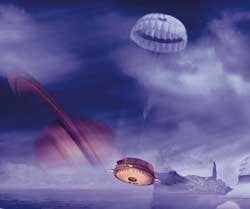Huygens Atmospheric Structure Instrument (HASI)
This instrument measures the physical and electrical properties of the moon’s atmosphere. It will determine the density, temperature, and pressure of the atmosphere and detect any gusts of wind. If Huygens lands on a liquid surface, HASI will be able to detect any wave motion.
Doppler Wind Experiment (DWE)
This instrument carries an ultra-stable oscillator to improve communication with Huygens. As winds in Titan’s atmosphere cause the probe to drift, the Doppler effect will cause the signal from DWE to shift slightly, allowing scientists to study the atmosphere’s dynamics.
Descent Imager/Spectral Radiometer (DISR)
This instrument consists of several sensors designed to image the surface and characterize the atmosphere. Sun sensors will measure changes in the intensity of light around the Sun caused by aerosol particles, allowing scientists to calculate the size and density of the particles. In addition, two cameras will observe the surface toward the end of the descent and, as the probe spins, build up a mosaic of pictures around the landing site. Another camera will look to the side to view the horizon and the underside of the cloud deck. For measurements of the surface, a lamp will switch on shortly before landing to augment the weak sunlight.
Gas Chromatograph Mass Spectrometer (GCMS)
This instrument analyzes gases to study the chemical composition of Titan’s atmosphere. It will also measure the composition of Titan’s surface if Huygens makes a safe landing.
Aerosol Collector and Pyrolyser (ACP)
This experiment draws in aerosol particles from two different altitudes in the atmosphere and then heats the samples in ovens to vaporize any volatile substances and decompose the complex organic compounds. The products of this pyrolysis will then be flushed along a pipe to the GCMS instrument, which will analyze the samples.
Surface-Science Package (SSP)
This instrument contains several sensors designed to determine the physical properties of Titan’s surface at the point of impact, whether the surface is solid or liquid. During the last few hundred feet of descent, an acoustic sounder will continuously determine the distance to the surface, measuring the rate of descent and the surface’s roughness. An accelerometer will record the change in speed at impact, indicating the hardness and structure of the surface. Another sensor will measure the tilt of the probe after landing and reveal any motion due to waves. If the surface proves to be liquid, other sensors will measure the ocean’s density, temperature, light-reflecting properties, and heat capacity.










